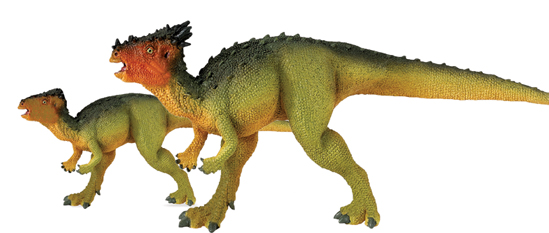The Juvenile Dracorex – An Exclusive Illustration
Adding a Juvenile Dracorex Dinosaur to the Safari Ltd Picture
After having carefully modified the Safari Ltd picture that was sent to us so that it depicted a more accurate Late Cretaceous scene, we added for extra affect an image of a juvenile Dracorex. It is likely that these members of the Pachycepahlosaurini (bone-headed dinosaurs) lived in small groups and younger members of the herd, sub-adults and juveniles probably stayed close to the adults for protection. It is also highly probable that these young animals would also have looked different from the older, more mature herd members, so we set about creating an image of a juvenile Dracorex using the Safari Ltd image of the Wild Safari Dinos Dracorex replica as a template.
Juvenile Dracorex
The Mum and Baby Dracorex
Picture credit: Everything Dinosaur
Changing an Adult Dinosaur into a Juvenile
First of all we reduced an image of an adult Dracorex in size. We could have “morphed” the body a little to give the juvenile a bigger head and larger eyes in proportion to the rest of its body, as seen in actual fossils of baby dinosaurs that have been discovered, but for the time being we kept the body shape roughly the same shape as the adult. We could use the Wild Safari Dinos Dracorex dinosaur model as our template.
Next, we toned down the orange colouration of the throat and the face, assuming that only adult, mature animals perhaps those old enough to breed or to exert some sort of social dominance over other herd members would develop such colourful markings.
The large crests, bumps and horns on the naris around the eyes and at the back of the head were removed, again the presumption was that such skull ornamentation was probably only present in older animals and these features would become more prominent as the youngsters grew. The raised scutes, along the flanks and running down the back-line of the adult replica were also removed.
We placed the image of the juvenile in close proximity to the adult Dracorex image, so that a comparison between the two could be made (ontogenic differences) and also to give a sense of scale. As stated earlier, juveniles probably stayed close to the older members of the herd for protection from predators.
So there you have it, Everything Dinosaur’s impression of a juvenile Dracorex, all we need now is more fossil material ascribed to this pachycephalosaur genus so we can see how wildly inaccurate we were!
To view the Safari Ltd range of prehistoric animal figures: Dinosaur Figures (Safari Ltd).


